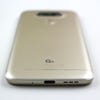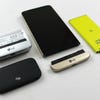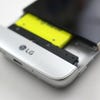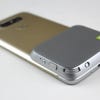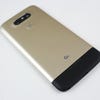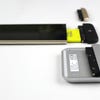LG G5 review
Has genuine hardware innovation returned to the smartphone market?
Browsing your local mobile phone emporium, it's hard not to feel a slight twinge of regret that we're no longer blessed with the kind of variety that typified the "feature" phone era; that wild and often unpredictable age before Apple and Google dominated the landscape and big-screen mobiles were the norm. Firms like Nokia, Samsung, Siemens, Sony Ericsson and Sagem weren't afraid to experiment with their handsets, creating products which desperately tried to differentiate themselves from their rivals in weird and wonderful ways. There was a joyful creativity at work, sadly absent from the modern smartphone sector. Today's handsets tend to follow a rigid template and any new idea that comes to market is quickly adopted by practically every manufacturer out of fear of being left behind. However, it would seem that LG - tired of sitting in the shadow of its competitors - has finally woken up to the value of offering something drastically different; the result is the G5, without a shadow of a doubt one of the most interesting phones we've seen in years.
The G5's gimmick is that it boasts a modular design, allowing the user to add special units - whimsically referred to by LG as "Friends" - to the bottom of the handset, augmenting it with additional features which, on any other device, would require an entire hardware refresh. The process of swapping out a module is simple; there's a small button on the lower-left edge of the phone and pressing this with your fingernail releases the bottom section, which also contains the speaker, microphone and USB Type-C charging port. Sliding this away from the main body of the phone reveals that the battery is also connected, and this has to be snapped off and fixed to another module before re-attaching it to the G5. The entire process takes seconds, and while the phone obviously turns off the moment the battery is removed, the boot time is thankfully quick. It's a neat trick and swiftly replacing a module in front of your friends is likely to garner more impressed glances than befuddled ones, but there are some niggles - on the unit we reviewed, the left-hand side of the module refused to fit flush against the body of the phone, leaving a noticeable gap.
Only two modules are available at present, both manufactured by LG. Cam Plus basically adds a bump to the back of the phone, intended to improve grip during photography. There's also a dial for controlling the phone's zoom, dedicated shutter and video recording buttons and a spring-loaded slider that fires up the camera application even when the phone is asleep. On paper, the Cam Plus makes sense; the physical camera controls make it easier to snap images swiftly and the bump - while a little unsightly - does indeed offer improved grip and stability during image capture. However, the module adds bulk and prevents the G5 from resting flat on a table.
Aside from these niggles, there's the fact that the Cam Plus module does nothing to enhance the quality of your images or video - there's no additional processing to speak of and it obviously can't improve the existing optics of the phone itself. The biggest selling point of this module is arguably the boost to battery life - there's a 1200 mAh power cell inside - but this is hardly an issue when you can simply carry a spare battery around with you and pop that in the G5 when needed (and while we're on the topic, the phone's 2800 mAh battery is more than capable of seeing you through an entire day of moderate usage).
The second module is an audio unit created in conjunction with Bang and Olufson which delivers 32-bit audio and can be used as a standalone unit with other devices when not bonded with your G5. A rather more expensive proposition, the Hi-Fi Plus module is for serious audiophiles only, especially when you consider that the G5's 24-bit DAC is already superior to the 16-bit DAC seen in the Galaxy S7. Audio playback is also reliant on the quality of the original recordings, so it's not going to make those fuzzy low-quality rips sound any better. With a retail price of around £150, the Hi-Fi Plus module could well be a complete non-starter for all but the most dedicated music buff, but you could argue that choice is everything with a modular phone.
The idea of a phone you can upgrade part by part is brilliant, but the big problem with LG's approach at this moment in time is that neither of the available modules are genuinely worth investing in. Another issue is that the vast majority of mobile users like to clad their phones in protective cases, and these naturally have to be removed and put aside in order to affix the modules. This rather basic point could well be what kills the "build-a-phone" concept: unless you're brave enough to walk around with a "naked" handset worth over £500, there's a fair chance that you'll ignore the add-ons entirely. LG hasn't confirmed if any other first-party modules are on the way and it's certainly not a given that third-party manufacturers will produce any, either. Still, you have to applaud the South Korean's company's chutzpah - even if the execution isn't quite as effective as we might have hoped. What we'd really like to see is a handset that goes to the next level, allowing you to swap out camera lenses, memory and perhaps even processors - something akin to Google's Project Ara.
Modules that bolt onto the phone's chassis are only one part of LG's "Friend" strategy, however. Additional peripherals - such as a VR headset and BB-8 lookalike - are also available. These are perhaps less exciting purely because they could be used on any phone - there's no clever modular connectivity at work here - but it does at least show that LG is trying to think outside the box when it comes to accessories. I didn't get to properly test the LG 360 VR headset during the review period as the unit I was sent steadfastly refused to boot up, but it feels lightweight and even comes in a handy plastic carry case. On the downside, there are no games available for the unit, just "experiences" and full-360 video sequences. The LG 360 is worn like a pair of glasses and therefore doesn't fit snugly on the head - this means a lot of light is allowed to leak in from the sides, which could impact the immersive effect.

| LG G5 | Galaxy S7 | Galaxy S6 | Google Nexus 5X | Google Nexus 6 | iPhone 6S | iPhone 6 | |
|---|---|---|---|---|---|---|---|
| Geekbench Single-Core | 2077 | 2171 | 1233 | 1263 | 1053 | 2552 | 1605 |
| Geekbench Multi-Core | 4135 | 6465 | 3964 | 3436 | 3081 | 4464 | 2901 |
| 3DMark Graphics | 31787 | 32404 | 22954 | 22074 | 24668 | 41968 | 22824 |
| 3DMark Physics | 21268 | 17730 | 17795 | 12641 | 17259 | 12998 | 9385 |
| 3DMark IceStorm Unlimited | 28639 | 27370 | 21565 | 18934 | 23205 | 28067 | 17304 |
| GFXBench T-Rex | 86.0 | 87.0 | 58.0 | 38.0 | 37.0 | 79.7 | 42.8 |
| GFXBench Manhattan | 31.0 | 29.0 | 25.9 | 16.2 | 18.0 | 40.3 | 18.1 |
While the LG G5's modular aspirations might turn heads and generate column inches, its design is sadly nothing to write home about. Say what you will about 2015's LG G4 and its leather back panel, at least it gave the phone a unique aesthetic identity - the G5 on the other hand is practically nondescript. It's not ugly by any means, just entirely unremarkable; LG's overdue shift to a metal chassis has been masked by the fact that the device is covered in a primer which makes it feel like plastic. Such is the confusion generated by this coating that the South Korean firm has been forced to issue a statement reassuring buyers that the G5 does indeed possess a metal body. LG maintains that the primer allows it to cover up those unsightly antenna strips, but the end result is a handset that looks and feels somewhat cheap, despite its flagship status. The rounded corners aim for the degree of elegance we've seen on the Galaxy S7 and iPhone 6S but fail to achieve the same effect, and the sharp edge which runs around the handset can make it mildly uncomfortable to hold.
On the front, the top edge of the screen slopes away in a manner which actually feels quite nice when you're swiping your finger down to bring up the notification pane, but the bottom edge - where the modules connect - makes the whole device look a bit unbalanced. On the left-hand side you'll find the volume rocker, while the power button - which includes an accurate and fast fingerprint scanner - is located on the back, just like it was on the Nexus 5X and 6P. I'm still rather torn on whether or not this positioning is a good idea; on one hand, it allows you to unlock your phone the moment your remove it from your pocket as your finger naturally rests on the back of the device, but when the handset is lying on a flat surface you have to pick it up to unlock it, unlike the Galaxy S7 and iPhone, which boast front-facing fingerprint scanners.
The LG G4 offered a massive 5.5 screen, but this successor has a smaller 5.3-inch IPS panel, boasting a 2560x1440 resolution. Despite the smaller display, the G5 is roughly the same size as the G4 thanks to its modular design. The screen itself is pin-sharp and showcases excellent colour depth and contrast. As we constantly find ourselves saying when reviewing non-AMOLED panels, it lacks the punch of the displays seen on Samsung's flagships, but colours are arguably softer and more realistic. In a neat touch, the G5 has an "always on" display, a trick the Galaxy S7 achieved thanks to the fact that black pixels on AMOLED panels are turned off and therefore draw no battery power.
The G5's LCD screen can't do this, so instead the display is dimmed so that the text is just about legible but power consumption is kept to a minimum. Amazingly, it sucks about the same amount of battery life as the "always on" option on the S7 - around one percent an hour - but has the benefit of providing more information. On Samsung's phone, it would only state if calls or messages were waiting for your attention, while on the G5 all manner of notifications are displayed, allowing you to see instantly what needs your attention without having to unlock the handset and power up the screen.
Thanks to the inclusion of Qualcomm's new Snapdragon 820 chipset, the G5 is very much at the cutting edge of mobile phone tech. The new processor supplies blistering performance and is aided by 4GB of RAM to keep things moving at an assured pace. At no point during the review period did the G5 ever feel anything less than supremely powerful, and no hiccups or pauses were detected, even under heavy load. In fact, we'd have to say this is the smoothest Android experience we've had, even more buttery-smooth than the powerful Galaxy S7. LG's custom UI skin is easy on the eye and doesn't bloat the phone with needless apps, but as ever all it takes is a quick trip to the Google Play store to install the Google Now launcher, which makes the phone look and feel like a stock, Nexus device.
It goes without saying that this power bleeds through into gaming, and - when twinned with the phone's roomy 5.3-inch screen - makes for an excellent entertainment platform. 3D titles run at a brisk pace, and the ability to carry a spare battery with you means you don't have to worry about draining your power by gaming on the go - a prime concern with handsets that don't allow you to replace the power cell. Given the G5's modular functionality it would be nice to see either LG or another manufacturer produce some kind of bolt-on physical gaming interface; these already exist in the form of peripherals which expand on spring-loaded mechanisms to grip your phone, but a more solid-feeling offering would be welcome.




Were it not for the G5's modular design, the feature which would have taken top billing is the dual-camera setup on the back of the handset. A 16-megapixel snapper is complimented by an 8-megapixel wide-angle (135 degrees, in fact) camera that takes in more than the human eyeball is capable of seeing, and this allows you to capture some pretty striking scenes. You can toggle between the two with the tap of an icon at the top of the screen - a process which takes less than a second - and it's hard to resist the temptation of snapping absolutely everything in that lush wide-angle viewpoint. While the wide angle lens isn't quite as good as the traditional 16-megapixel snapper - it has a f/2.4 aperture, isn't great in the dark and produces images that are quite fuzzy under closer inspection - it's not an exaggeration to say that it's arguably the most appealing thing about the whole phone.
During the review period we lost count of the number of times we appreciated having that expanded view; landscape shots are made more dramatic and detailed, while group photos are a breeze - you'll never have to worry about cropping off someone's face ever again. Rumour has it that Apple is looking at including a second wide-angle camera in its next iPhone, and having spent some time with the G5, we're not at all surprised; just as LG is trying to do something fresh and different when it comes to expandability, it has also changed the game with the camera, wisely acknowledging that mobile imaging has gotten so refined that something unique is needed to stand out from the crowd.
Elsewhere, the phone features support for MicroSD cards but - like the Galaxy S7 - sadly doesn't take advantage of Android 6.0's "adoptable storage" feature, where MicroSD cards can be treated as part of the internal memory by the OS and are encrypted so that once inserted and "adopted" they can only be used with that phone. In the G5's case, the card is ring-fenced away from the phone's 32GB of space, and while this is good news for those who like to hot-swap media with other devices, it's a real shame that there wasn't at least the option to absorb MicroSD cards into the main memory.




USB Type-C is included with the G5, which means that your old Micro USB charger won't work here. Samsung held back on upgrading to Type-C on the Galaxy S7, but it's only a matter of time before it takes over entirely, and many other manufacturers have already made the switch in 2016. Despite Type-C not being officially supported by Qualcomm's Quick Charge 3.0 standard, the phone comes equipped with it - but sadly not a 3.0 charger. The one you get in the box is 2.0, but even so, it will fully charge the phone's 2800 mAh battery in around an hour. The modular setup means that water resistance was never going to be on the cards, and the device also lacks wireless charging - both of these are features which are present on the S7, arguably this phone's biggest rival.
LG G5: the Digital Foundry verdict
With Samsung's recent resurgence and increased competition from its Android rivals, LG has had to do something different with its 2016 flagship, and while the dalliance with modular design isn't quite as impressive as the Korean manufacturer would have you believe, it's still a plus point which differentiates the device from the countless "me too" smartphones on the market. Even if the Cam Plus and Hi-Fi Plus modules aren't of interest, old-school phone users will definitely appreciate being able to swap out the battery, something which no other Android flagship offers in 2016. The G5's excellent dual-camera configuration is another bonus, with the wide-angle camera being a genuinely exciting development in the mainstream smartphone arena - expect to see it copied by many major rivals over the next few years.
Take into account the powerful internal tech, smooth user experience and likeable UI and you've got a flagship phone which LG has every reason to be very proud of - the only real downsides are the rather plain design and the fact that the modular approach brings with it some annoying build quality concerns and the need to remove those protective cases that mobile users have grown so accustomed to as handsets have increased in value over the years. While the modular gamble might not have paid off as handsomely as many expected or hoped, we should all be thankful that companies like LG are starting to experiment in order to gain a little more exposure in what is becoming an increasingly stagnant marketplace.
LG G5 review unit kindly provided by www.mobilefun.co.uk.




